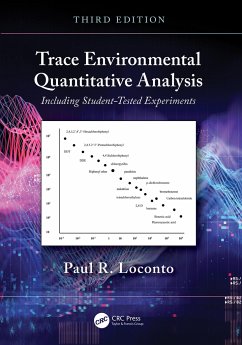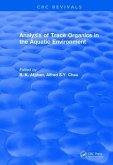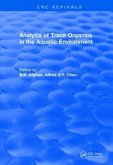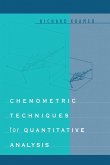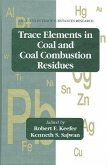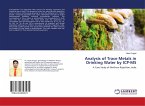- Broschiertes Buch
- Merkliste
- Auf die Merkliste
- Bewerten Bewerten
- Teilen
- Produkt teilen
- Produkterinnerung
- Produkterinnerung
A thorough and timely update, this new edition presents principles, techniques and applications in this sub-discipline of analytical chemistry for quantifying traces of potentially toxic organic and inorganic chemical substances found in air, soil, fish and water as well as serum, plasma, urine, and other body fluids.
Andere Kunden interessierten sich auch für
![Analysis of Trace Organics in the Aquatic Environment Analysis of Trace Organics in the Aquatic Environment]() B. K. AfghanAnalysis of Trace Organics in the Aquatic Environment85,99 €
B. K. AfghanAnalysis of Trace Organics in the Aquatic Environment85,99 €![Analysis of Trace Organics in the Aquatic Environment Analysis of Trace Organics in the Aquatic Environment]() B. K. AfghanAnalysis of Trace Organics in the Aquatic Environment301,99 €
B. K. AfghanAnalysis of Trace Organics in the Aquatic Environment301,99 €![Chemometric Techniques for Quantitative Analysis Chemometric Techniques for Quantitative Analysis]() Richard KramerChemometric Techniques for Quantitative Analysis70,99 €
Richard KramerChemometric Techniques for Quantitative Analysis70,99 €![Quantitative Risk Assessment for Environmental and Occupational Health Quantitative Risk Assessment for Environmental and Occupational Health]() William H. HallenbeckQuantitative Risk Assessment for Environmental and Occupational Health302,99 €
William H. HallenbeckQuantitative Risk Assessment for Environmental and Occupational Health302,99 €![Trace Elements in Coal and Coal Combustion Residues Trace Elements in Coal and Coal Combustion Residues]() Robert F. KeeferTrace Elements in Coal and Coal Combustion Residues404,99 €
Robert F. KeeferTrace Elements in Coal and Coal Combustion Residues404,99 €![Analysis of Trace Metals in Drinking Water by ICP-MS Analysis of Trace Metals in Drinking Water by ICP-MS]() Vikas DuggalAnalysis of Trace Metals in Drinking Water by ICP-MS25,99 €
Vikas DuggalAnalysis of Trace Metals in Drinking Water by ICP-MS25,99 €![Quantitative Ecotoxicology Quantitative Ecotoxicology]() Michael C. NewmanQuantitative Ecotoxicology247,99 €
Michael C. NewmanQuantitative Ecotoxicology247,99 €-
-
-
A thorough and timely update, this new edition presents principles, techniques and applications in this sub-discipline of analytical chemistry for quantifying traces of potentially toxic organic and inorganic chemical substances found in air, soil, fish and water as well as serum, plasma, urine, and other body fluids.
Hinweis: Dieser Artikel kann nur an eine deutsche Lieferadresse ausgeliefert werden.
Hinweis: Dieser Artikel kann nur an eine deutsche Lieferadresse ausgeliefert werden.
Produktdetails
- Produktdetails
- Verlag: CRC Press
- 3. Auflage
- Seitenzahl: 768
- Erscheinungstermin: 29. Januar 2024
- Englisch
- Abmessung: 254mm x 178mm x 41mm
- Gewicht: 1417g
- ISBN-13: 9780367631062
- ISBN-10: 0367631067
- Artikelnr.: 69877356
- Herstellerkennzeichnung
- Libri GmbH
- Europaallee 1
- 36244 Bad Hersfeld
- gpsr@libri.de
- Verlag: CRC Press
- 3. Auflage
- Seitenzahl: 768
- Erscheinungstermin: 29. Januar 2024
- Englisch
- Abmessung: 254mm x 178mm x 41mm
- Gewicht: 1417g
- ISBN-13: 9780367631062
- ISBN-10: 0367631067
- Artikelnr.: 69877356
- Herstellerkennzeichnung
- Libri GmbH
- Europaallee 1
- 36244 Bad Hersfeld
- gpsr@libri.de
Paul R. Loconto holds a PhD. in analytical chemistry and an MS in physical chemistry. He has published 35 peer-reviewed papers in analytical chemistry and in chemical education. He has given over 40 talks and poster presentations at various workshops, meetings, and conferences. After brief stints at the American Cyanamid Co., Stamford, CT, and the Dow Chemical Co., Midland, MI, in 1974, Dr. Loconto began teaching introductory, environmental, general and organic chemistry at Dutchess Community College, Poughkeepsie, NY. He joined NANCO Environmental Services in Wappingers Falls, NY, as R&D manager in 1986. In 1990, he joined the Michigan Biotechnology Institute in Lansing. In 1992, he became the laboratory manager for the graduate program in Environmental Engineering at Michigan State University, East Lansing, where he conducted analytical method development for both the NIEHS analytical core and the EPA Hazardous Substance Research Center while coordinating the development of an instructional analytical laboratory for the graduate school. In 2001, he joined the Michigan Department of Community Health, Bureau of Laboratories, as a Laboratory Scientist Specialist. Here, in addition to training new employees on how to use GC-MS, GC-MS/MS, and GC-AED instruments, as well as SPE sample prep techniques, he taught co-workers how to satisfy QA/QC requirements. He focused on developing analytical methods for biomonitoring while conducting trace quantitative analysis in support of the Laboratory Response Network for the U.S. Centers for Disease Control and Prevention (CDC). He retired in late 2013, yet continues as a consultant, educator, and writer.
Preface to the Third Edition. About the Author. About the Contributors.
Chapter 1 Introduction to Trace Environmental Quantitative Analysis (TEQA).
Chapter 2 Calibration, Verification, Quantification, Statistical Treatment
of Analytical Data, Detection Limits, and Quality Assurance/ Quality
Control. Chapter 3 Sample Preparation Techniques to Isolate and Recover
Organics and Inorganics. Chapter 4 Determinative Techniques to Measure
Organics and Inorganics. Chapter 5 Student- Tested Laboratory Experiments.
Appendix A: Glossary. Appendix B: QA/ QC Illustrated. Appendix C: A Primer
on the Basics of Probability and Statistics for Some and a Quick Review for
Others. Appendix D: Quality Control for Environmental- Health TEQA: Levey-
Jennings Plots and Westgard Rules. Appendix E: Innovative Sample Prep Flow
Charts for TEQA. Appendix F: Quantitating VOCs in Serum Using Automated
Headspace-SPME/ Cryo- Focusing/ Isotope Dilution/ Capillary GC-MS. Appendix
G: Using a Pooled Standard Deviation to Find the Uncertainty in the Percent
Recovery for the Priority Pollutant Phenol Using Reversed- Phase SPE from
Spiked Water by Converting Phenol to its Pyrazol- 3- One Complex: Comparing
In Situ vs. Synthesized Experimental Approaches. Appendix H: Laboratory
Glass & Instrument Designs. Appendix I: Useful Potpourri for Environmental
Analytical Chemists. Appendix J: Contributing Authors: Brief Introduction.
Index.
Chapter 1 Introduction to Trace Environmental Quantitative Analysis (TEQA).
Chapter 2 Calibration, Verification, Quantification, Statistical Treatment
of Analytical Data, Detection Limits, and Quality Assurance/ Quality
Control. Chapter 3 Sample Preparation Techniques to Isolate and Recover
Organics and Inorganics. Chapter 4 Determinative Techniques to Measure
Organics and Inorganics. Chapter 5 Student- Tested Laboratory Experiments.
Appendix A: Glossary. Appendix B: QA/ QC Illustrated. Appendix C: A Primer
on the Basics of Probability and Statistics for Some and a Quick Review for
Others. Appendix D: Quality Control for Environmental- Health TEQA: Levey-
Jennings Plots and Westgard Rules. Appendix E: Innovative Sample Prep Flow
Charts for TEQA. Appendix F: Quantitating VOCs in Serum Using Automated
Headspace-SPME/ Cryo- Focusing/ Isotope Dilution/ Capillary GC-MS. Appendix
G: Using a Pooled Standard Deviation to Find the Uncertainty in the Percent
Recovery for the Priority Pollutant Phenol Using Reversed- Phase SPE from
Spiked Water by Converting Phenol to its Pyrazol- 3- One Complex: Comparing
In Situ vs. Synthesized Experimental Approaches. Appendix H: Laboratory
Glass & Instrument Designs. Appendix I: Useful Potpourri for Environmental
Analytical Chemists. Appendix J: Contributing Authors: Brief Introduction.
Index.
Preface to the Third Edition. About the Author. About the Contributors.
Chapter 1 Introduction to Trace Environmental Quantitative Analysis (TEQA).
Chapter 2 Calibration, Verification, Quantification, Statistical Treatment
of Analytical Data, Detection Limits, and Quality Assurance/ Quality
Control. Chapter 3 Sample Preparation Techniques to Isolate and Recover
Organics and Inorganics. Chapter 4 Determinative Techniques to Measure
Organics and Inorganics. Chapter 5 Student- Tested Laboratory Experiments.
Appendix A: Glossary. Appendix B: QA/ QC Illustrated. Appendix C: A Primer
on the Basics of Probability and Statistics for Some and a Quick Review for
Others. Appendix D: Quality Control for Environmental- Health TEQA: Levey-
Jennings Plots and Westgard Rules. Appendix E: Innovative Sample Prep Flow
Charts for TEQA. Appendix F: Quantitating VOCs in Serum Using Automated
Headspace-SPME/ Cryo- Focusing/ Isotope Dilution/ Capillary GC-MS. Appendix
G: Using a Pooled Standard Deviation to Find the Uncertainty in the Percent
Recovery for the Priority Pollutant Phenol Using Reversed- Phase SPE from
Spiked Water by Converting Phenol to its Pyrazol- 3- One Complex: Comparing
In Situ vs. Synthesized Experimental Approaches. Appendix H: Laboratory
Glass & Instrument Designs. Appendix I: Useful Potpourri for Environmental
Analytical Chemists. Appendix J: Contributing Authors: Brief Introduction.
Index.
Chapter 1 Introduction to Trace Environmental Quantitative Analysis (TEQA).
Chapter 2 Calibration, Verification, Quantification, Statistical Treatment
of Analytical Data, Detection Limits, and Quality Assurance/ Quality
Control. Chapter 3 Sample Preparation Techniques to Isolate and Recover
Organics and Inorganics. Chapter 4 Determinative Techniques to Measure
Organics and Inorganics. Chapter 5 Student- Tested Laboratory Experiments.
Appendix A: Glossary. Appendix B: QA/ QC Illustrated. Appendix C: A Primer
on the Basics of Probability and Statistics for Some and a Quick Review for
Others. Appendix D: Quality Control for Environmental- Health TEQA: Levey-
Jennings Plots and Westgard Rules. Appendix E: Innovative Sample Prep Flow
Charts for TEQA. Appendix F: Quantitating VOCs in Serum Using Automated
Headspace-SPME/ Cryo- Focusing/ Isotope Dilution/ Capillary GC-MS. Appendix
G: Using a Pooled Standard Deviation to Find the Uncertainty in the Percent
Recovery for the Priority Pollutant Phenol Using Reversed- Phase SPE from
Spiked Water by Converting Phenol to its Pyrazol- 3- One Complex: Comparing
In Situ vs. Synthesized Experimental Approaches. Appendix H: Laboratory
Glass & Instrument Designs. Appendix I: Useful Potpourri for Environmental
Analytical Chemists. Appendix J: Contributing Authors: Brief Introduction.
Index.

